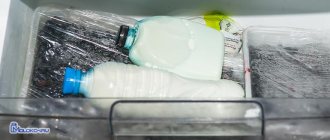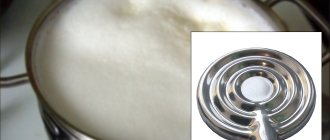Why does it start to deteriorate?
Food with signs of spoilage looks like this: an unpleasant smell and taste, inclusion of mold (dark spots), a change in consistency ("water" appears), etc. This occurs due to the fact that microorganisms begin to multiply in the food, releasing life activity toxins harmful to humans. If storage conditions are not met, such as increased temperature, this process proceeds much faster.
For example, according to the rules for the retail trade of dairy products on the market, sour cream and cottage cheese must be stored in barrels or flasks, and after opening, covered with gauze or plywood lids covered with gauze. It is unacceptable to leave spoons in them or reuse them. If you violate even one norm, the product will quickly become unusable.
What GOST says: varieties and shelf life of sour cream
Classic sour cream is made from fresh cream and fermented milk starter. She has:
- homogeneous thick milky consistency;
- glossy surface;
- sour taste.
When purchasing a product, look carefully at the packaging. The expiration date on it indicates how long the content of beneficial bacteria will meet the established standards. The storage duration is counted from the time of complete completion of the production process.
Note to the hostess
When indicating an expiration date of more than 2 weeks, you should pay attention to the components of the product. Surrogate additives can increase the shelf life to 1 month or even more.
Varieties of sour cream
GOST R 52092-2003 – certificate of compliance with established standards in the manufacture of products and the absence of harmful impurities. Sour cream, the GOST of which requires storage from 5 to 10 days, contains natural ingredients:
- animal fats;
- milk proteins;
- potassium;
- calcium;
- magnesium;
- iron and other minerals.
The classification of sour cream is based on 3 characteristics:
- Type of cream used as raw material: normalized, pasteurized, reconstituted and recombined (mixed cream from milk of different fat content).
- Fat percentage: high fat, fat, low fat and low fat.
- Type of heat treatment: pasteurization, sterilization, ultra-high temperature.
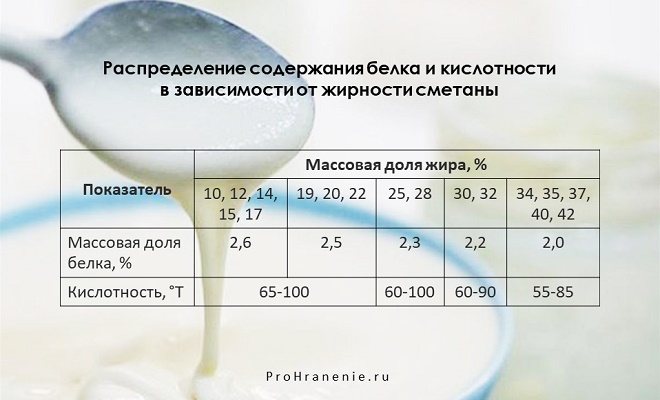
The protein content and acidity of sour cream decrease with increasing fat content
Sour cream product: how not to buy a fake?
The question of how to distinguish real sour cream from a product similar to it in appearance, consistency and color is very relevant. After all, in a fake:
- there are flavor intensifiers and preservatives that significantly increase shelf life;
- animal fats are replaced by vegetable fats;
- genetically modified soybeans often become a substitute for milk protein.
The presence of these components does not have the best effect on health.
How to choose a healthy natural product prepared in the classic way?
We also recommend reading:
Fresh dill all year round: how to prepare and preserve vitamin greens Melon for the New Year: how to preserve the product at home How and where to properly store bananas at home so that they do not turn black Dry and boiled buckwheat: how and how long to store. Saving secrets
- First of all, we pay attention to the packaging. The first thing that catches your eye is the name. If the label says, for example, “Smetanka”, this is a sour cream product. The name “sour cream” is a generally accepted term and indicates that the product is manufactured according to GOST standards.
- Optimistic labels like “100% natural product” should also be taken into account with a grain of salt. They are allowed by regulations, but do not always guarantee that the classic recipe is used.
- The norm of fermented milk bacteria in sour cream should be at least 107 per 1 g. The special marking CFU 107 indicates this.
- The expiration date should not exceed 14 days from the date of manufacture of the product.
- The natural product is milky white in color with a slight sheen. If you open the jar and see a matte surface, you are most likely faced with adulteration. Dullness is created by special food thickeners and chemical preservatives.
Do you know that…
The cost of a sour cream product is usually lower than a natural one.
Deadlines
In a refrigerator
The production of sour cream is regulated by GOST 31452-2012. It says that sour cream is a product obtained by fermenting cream with the addition of dairy derivatives and sourdough. The mass fraction of fat should be at least 10%, more precisely: the range for this type of product is 10-58%.
Russian enterprises make four types of sour cream:
- dietary - 10%;
- dining room - 20-25%;
- ordinary - 30-36%;
- amateur - 40%.
A product with a fat content of 40% is considered the best. Fattier ones already have an oily taste and consistency, which is why consumers do not like them.
Sour cream must be stored at a temperature of +6...+8 degrees Celsius, and its shelf life is no more than 14 days. For homemade village sour cream, this figure is 3 days.
Storage time can be increased due to preservatives in the composition.
Let's see how long it lasts for some brands of sour cream and dishes based on it:
- House in the village - 20 days;
- Prostokvashino - 25 days;
- Merry milkman - 21 days;
- sour cream - 6 hours;
- cake with sour cream - 6 hours (if no preservatives were used);
- sour cream sauces - 2 hours from the moment of preparation.
The data is valid for closed store packaging - after opening the time is reduced to three days.
It is not recommended to keep fermented milk products in open form or in plastic consumer containers. After opening the package, you need to put it in a glass or ceramic container, seal it with a lid and put it in the refrigerator.
In the freezer
Fermented milk products can be deep frozen. For example, cottage cheese easily tolerates freezing.
This way, their storage time will increase significantly - up to about six months, but the taste and texture will no longer be the same, and the amount of useful microelements will decrease. You need to freeze sour milk in glass or ceramics. For convenience, indicate the date of freezing of the dairy product on the glass container with a permanent marker to avoid use after the expiration date.
Without refrigerator
If there is no refrigerator, you can keep the sour cream suitable for consumption for no more than 24 hours. To do this, you need to put it in a glass plate, place it in a vessel with cold water and cover it with a cloth, dipping the ends into the water.
Under normal room conditions, products can begin to deteriorate within three hours. The first sign will be the separation of serum. If you notice such a process, you must use the product as soon as possible.
In a vacuum container
Vacuum packaging can certainly extend the life of food by 3-5 times. This is achieved due to the lack of oxygen inside, which does not allow microorganisms to multiply.
Storage without refrigeration
Already at +8-10°, unopened sour cream will sour in 5-6 hours. Opened sour cream will begin to deteriorate in an hour. The higher the air temperature, the faster the acidification process will occur.
The shelf life of sour cream can be increased to 24 hours as follows:
- Transfer the product inside a dry, clean glass jar or ceramic (clay) pot.
- Pour cold water inside a tall saucepan so that the filled jar is immersed up to its shoulders.
- Place the container with the fermented milk product on the bottom of the pan and cover its neck with a damp natural cloth. The edge of the matter should be in the water.
- Find the coolest place in the house for the pan, away from direct sunlight.
If you lower the container into the cellar, the shelf life of sour cream can be extended to two days.
GOST requirements
Classic sour cream is made from cream and sourdough. It is characterized by the following features:
- shiny surface;
- uniform thick texture;
- sour taste.
When purchasing a product, you should examine the packaging. Shelf life means how long the volume of beneficial microorganisms will meet the standards. The storage period is calculated from the moment the production process is completed.
If the period indicated on the package exceeds 2 weeks, it is worth studying the composition. The presence of surrogate components allows you to increase the shelf life to 1 month or more.
GOST R 52092-2003 is considered proof of compliance with standard standards in the production of products. It contains no dangerous components. If the standard provides for a shelf life of 5-10 days, you can be sure that the composition of the sour cream is natural. This means that it contains the following components:
- milk proteins;
- animal fats;
- calcium;
- potassium;
- iron;
- magnesium.
Shelf life of homemade sour cream
A product produced at home is in many ways superior in quality and content of nutrients to store-bought analogues, even the highest quality ones. If all storage standards and recommendations are followed, the homemade product will deteriorate much faster. It must be used for food within 3-7 days, while the temperature regime is the same as for a purchased product.
Advice! When the temperature drops to zero, storage is extended to a maximum of 10 days.
How to properly store closed and open?
The product should be kept at low temperatures from +2˚С to +6˚С . The refrigerator perfectly meets these requirements.
Information about the conditions and storage period before and after opening the package is always contained on the label; they are established by the specific manufacturer .
Before opening the package, sour cream can be stored within the expiration date indicated by the manufacturer.
The average storage time for treats in the refrigerator in an open container is as follows:
- natural store-bought sour cream - 3-6 days;
- homemade product - 1-3 days;
- industrial sour cream with additives and preservatives - 14-30 days.
You can prolong the effect of beneficial properties and delicate taste by transferring the product from store containers into glass or ceramic containers and securing it with a very tight lid.
In any case, the further from the moment of release, the less substances necessary for the body remain in it and the more unpleasant sensations there are - a taste of bitterness or sourness .
Read in this article about the shelf life and storage conditions of cottage cheese according to GOST.
Storing various sour cream-based products
We will analyze not only the shelf life of sour cream, but also products based on it. Often it is a component of various dishes and desserts. In this case, the product will not be stored for a long time. Therefore, the freshest ingredient is chosen for processing. Be sure to check the production date.
How long are various dishes and desserts stored?
- sour cream. It is used for cakes, pastries, can be used as an independent dessert, and is sometimes mixed with gelatin. The composition is unstable. Therefore, it can be stored for up to 5 hours. But desserts can be kept for up to a day and a half in the refrigerator;
- sauces. When adding herbs and vegetables, it is advisable to use them within 3-4 hours. The mixture with soy sauce and lemon lasts a little longer. The duo with garlic spoils quickly. Soon an unpleasant odor appears;
- sour cream products. Substitutes for natural sour cream. They are stored for a very long time due to the addition of vegetable fats. Preservative components. They can stand for a whole month without signs of deterioration.
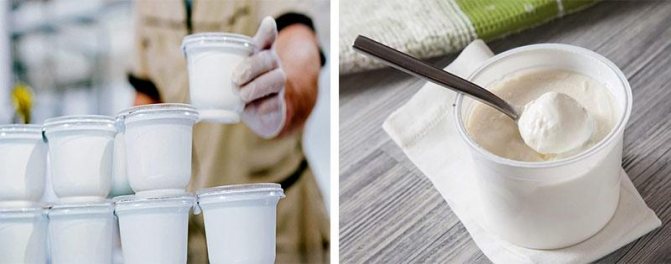
Storing an open or closed package of sour cream
Sour cream turns sour most quickly when added to vegetable salads. Therefore, it is necessary to season such snacks with sauce just before serving.
Standard expiration dates
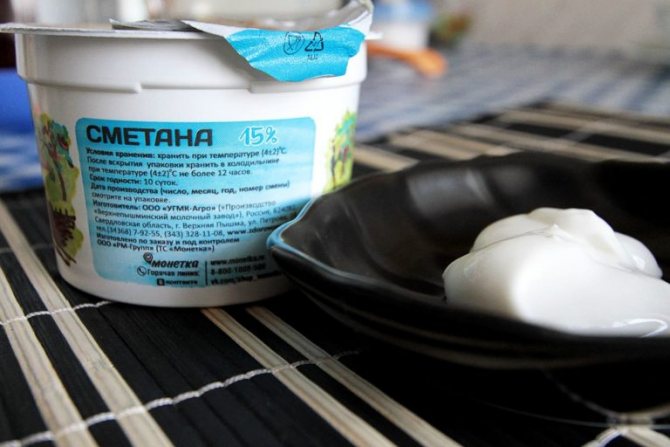
Sour cream is produced in different percentages of fat content:
- dietary - 10%;
- dessert - 20%;
- standard - 30%;
- amateur - 40%.
Shelf life depends on the composition. The natural product is made using sourdough and cream, so it is perishable. If sour cream is prepared taking into account GOST, then it can be stored in packaging for 5 to 10 days.
Storage rules at home
- According to clause 8 of GOST 31452-2012, sour cream should be stored at a temperature from 2⁰С to 6⁰С. In everyday life, this temperature regime is ensured in a refrigerator.
- The product retains its quality until the expiration date indicated on the individual or transport packaging.
- It is not recommended to leave the packaging at room temperature for a long time: this will reduce the shelf life to 24 hours.
- Do not freeze sour cream, otherwise grains will appear in the mass and the taste will change.
- If you do not plan to use the entire amount of the product at once, use a clean, dry spoon each time: moisture or food contaminants getting into the mass will cause the proliferation of pathogenic bacteria.
- Try not to shake the product container during transportation or in everyday situations, as whey may be released.
- Sour cream “loves” glass and ceramics, but the product in plastic deteriorates faster.
To avoid eating spoiled products, it is important before purchasing to make sure that the product is displayed in the store in accordance with the storage rules established by the manufacturer, assess the integrity of the packaging and expiration date. Our experts have prepared a series of articles from which you will learn about the storage rules and shelf life of dairy and fermented milk products: fresh and powdered milk, yogurt, butter, condensed milk, ice cream, kefir and cottage cheese.
How long does it last open?
An opened container of sour cream has a much shorter shelf life, and this should be taken into account when using it for food. Storage is carried out at a temperature no higher than 6 degrees Celsius, but this will also briefly delay the development of bacteria. Within three days there will be sour sour cream, which is better not to eat.
What to do if the product's expiration date has passed? It would be a pity to simply throw away an expired product, but it is dangerous to consume, since the poisoning can be very severe. Usually in such cases sour cream is used in baking, it is added to dough, yeast or shortbread will only thank you for such an increase.
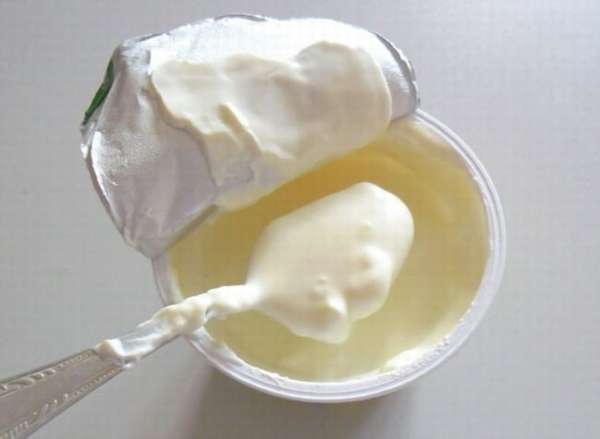
What it is?
From the point of view of the law, the shelf life of sour cream is the time period after which the fermented milk product loses its quality and can no longer be consumed. The indicator guarantees: the product is safe for life and health. Naturally, subject to storage conditions.
Reference. In the Russian Federation, sour cream is produced according to the interstate standard GOST 31452-2012. The law regulates its production of a fermented milk product based on cream from cow's milk, packaged in special packaging and intended for food. All other “variations on the theme” of sour cream - sour cream products and substances enriched with other ingredients are not related to the specified GOST.
GOST 31452-2012 does not contain specific information about expiration dates. These time frames MUST be established by manufacturers, guided by the technical regulations of the Law of the Russian Federation “On Technical Regulation” No. 184-FZ of December 27, 2002.
If the buyer receives a product without indicating significant data, the manufacturer is responsible for the safety of the products sold for 10 years from the date of sale. Of course, sour cream with such a long shelf life does not exist in nature, so the marking applied to the packaging protects the manufacturer from unfounded claims from customers.
The shelf life of sour cream is the period of time during which the fermented milk product retains its qualities and characteristics established and described in the relevant regulations (GOST, TU, SanPiN). This indicator ensures that the product is edible.
The shelf life is not the same as the expiration date, since after the first period of time the sour cream is not considered lost, but expired sour milk can no longer be eaten.
Sour cream is a product of bacterial ripening, so acidity and other indicators may change during storage. This is the result of the activity of microorganisms and native enzymes. Since it is difficult to control this process from the outside, fermented milk products may change their taste during storage.
The packaging of ready-made sour cream always indicates the production date - this is the day on which the production process was completed and the freshly prepared sour cream was completely ready for sale.
What happens?
Sour cream should have a thick and homogeneous composition, a glossy surface, without foreign tastes and odors , white or light cream color.
Minor graininess is allowed.
The content of lactic acid bacteria is not less than 107 per 1g of product.
On the packaging it is labeled as follows: CFU 107 .
Sour cream is classified according to the following criteria :
- by type of raw material (normalized, sterilized, recombined cream);
- by fat content (low-fat, low-fat, classic, fatty, high-fat);
- according to processing mode (pasteurized, sterilized, processed at ultra-high temperature).
When buying sour cream in a store, you need to focus on the packaging, composition , date and temperature conditions at which it is stored on the counter.





